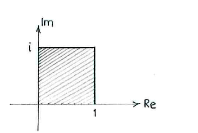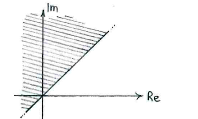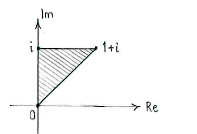Lösung 3.2:2b
Aus Online Mathematik Brückenkurs 2
(Unterschied zwischen Versionen)
| (Der Versionsvergleich bezieht 4 dazwischen liegende Versionen mit ein.) | |||
| Zeile 1: | Zeile 1: | ||
| - | + | Wir können die Ungleichung <math> 0\leq \mathop{\rm Re} z \leq \mathop{\rm Im} z \leq 1</math> in mehrere Ungleichungen aufteilen: | |
| - | + | ||
| - | <math>\ | + | :*<math>0 \leq \mathop{\rm Re} z \leq 1\,</math>, |
| - | 0 | + | :*<math>0 \leq \mathop{\rm Im}z \leq 1\,</math>, |
| - | + | :*<math>\mathop{\rm Re}z \leq \mathop{\rm Im}z\,\textrm{.}</math> | |
| - | + | Die ersten zwei Ungleichungen bilden ein Einheitsquadrat in der komplexen Zahlenebene. | |
| - | + | ||
| - | + | ||
| - | + | ||
[[Image:3_2_2_b1.gif|center]] | [[Image:3_2_2_b1.gif|center]] | ||
| - | + | Die letzte Ungleichung bedeutet, dass der Realteil von <math>z</math> gleich oder geringer als der Imaginärteil von <math>z</math> sein soll. Also muss <math>z</math> links von der Gerade <math>y=x</math> liegen, wo <math>x=\mathop{\rm Re} z</math> und <math>y = \mathop{\rm Im} z</math>. | |
[[Image:3_2_2_b2.gif|center]] | [[Image:3_2_2_b2.gif|center]] | ||
| - | + | Zusammen definieren die Ungleichungen ein Dreieck mit den Eckpunkten <math>0</math>, <math>i</math> und <math>1+i</math>. | |
[[Image:3_2_2_b3.gif|center]] | [[Image:3_2_2_b3.gif|center]] | ||
| - | |||
| - | {{NAVCONTENT_STOP}} | ||
Aktuelle Version
Wir können die Ungleichung \displaystyle 0\leq \mathop{\rm Re} z \leq \mathop{\rm Im} z \leq 1 in mehrere Ungleichungen aufteilen:
- \displaystyle 0 \leq \mathop{\rm Re} z \leq 1\,,
- \displaystyle 0 \leq \mathop{\rm Im}z \leq 1\,,
- \displaystyle \mathop{\rm Re}z \leq \mathop{\rm Im}z\,\textrm{.}
Die ersten zwei Ungleichungen bilden ein Einheitsquadrat in der komplexen Zahlenebene.
Die letzte Ungleichung bedeutet, dass der Realteil von \displaystyle z gleich oder geringer als der Imaginärteil von \displaystyle z sein soll. Also muss \displaystyle z links von der Gerade \displaystyle y=x liegen, wo \displaystyle x=\mathop{\rm Re} z und \displaystyle y = \mathop{\rm Im} z.
Zusammen definieren die Ungleichungen ein Dreieck mit den Eckpunkten \displaystyle 0, \displaystyle i und \displaystyle 1+i.



